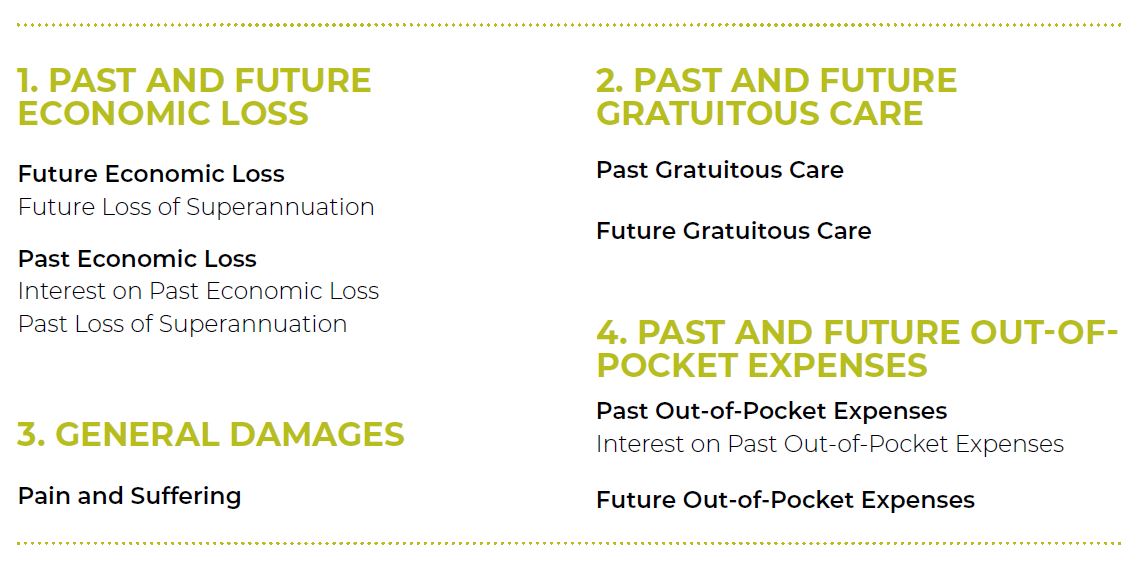There’s medical negligence. And then there’s medical negligence compensation.
So far, this series has been about medical negligence.
But now, it's going to focus on quantifying the financial impact of this negligence.
This financial impact is often referred to as “damages” or "compensation".
And, simply put, damages are the difference between the position of a person before the incident and the position of the person after the incident.

'Damages' assesses the difference in a person's life before and after the accident.
To say a person has suffered damages is to invite a comparison between what would have been, and what now is.
In medical negligence, we divide the impacts into four main quantifiable areas called ‘heads of damage’.
The main heads of damage we will discuss are:
- 1Past and future economic loss;
- 2Past and future gratuitous care;
- 3Pain and suffering;
- 4Past and future out-of-pocket expenses.
These heads of damage cover a vast array of costs (or loss of earnings) incurred by a victim of medical negligence.
Things such as an inability to return to work, wages for the family members who care for you, monetizing your loss of enjoyment in life, immediate and future medical expenses - the list goes on.
These heads of damage are what makes up your total compensation amount from an insurer.
And, since everyone's number 1 question after medical negligence is 'will a claim be worth it?', we've created a 5-part series and downloadable workbook for you to quantify all four heads of damage, all on your own.
That way you can know what can be covered, and the extent to which it can be covered.
Or, in other words, you can know the potential compensation payout you'd receive for your medical negligence.
One download between you and your key to compensation...
Want to fast track the process with our free interactive workbook?
Knowing your potential compensation is critical for determining how to approach holding your doctor accountable. That's because there're two ways you can hold a doctor accountable, and it hinges on how much your claim is worth.
But why does it depend on that? And why does it differ to other negligence claims like car accidents? Why do I have to have such high damages when I didn't do anything wrong? After all, the doctor was negligent regardless of my payout - right?
Well, technically, that's right.
But there's one unique aspect of medical negligence claims that make your damages calculation vital...
It's time to call in the professionals.
You might’ve identified a breach of duty of care after our first article.
But whilst you might think your doctor has breached, the judge needs more than just your word or the word of a lawyer to believe the practitioner was at fault.
And that's because medical treatment is not a lay person's or lawyer's area of expertise.
Most of the public have limited medical knowledge. They don’t know if a medical procedure is right or wrong.
What you need as a claimant is another medical practitioner to agree with you, saying that the treating doctor (or system) got it wrong.
And that's where things can get expensive.
That's because the majority of doctors don’t want to criticise the performance of their peers. Not in public. And certainly not in the courtroom.
The band of brothers (and sisters) closes very tightly around itself when one of their own stand accused of sub-standard, careless, or reckless treatment.
To find such a doctor willing to testify against his colleague can be like finding a needle in a haystack.
As a result, it is common practice to ask medical professionals from interstate and overseas to testify.
The willingness of these ‘out-of-state’ professionals to testify is sweetened by them being paid a fee to write a report.
And these reports cost anywhere from between $3,000 to $20,000.
And it doesn’t end there.
In a lot of medical negligence cases, there will be several doctors, nurses, and medical staff “in the gun.” This can require several reports from several sources.
For example, Doug, a carpenter, has an operation to fix a broken bone. It isn’t set correctly, and the wound becomes infected. Eventually, he has his leg amputated.
And as the requirement for these reports continues to pile up, it becomes apparent that the financial losses suffered by the negligence need to be significant enough to outweigh the costs of these reports.
At the very least, we need to get a report from an orthopedic surgeon to suggest the first operation had gone wrong. Then perhaps a report from a general surgeon about the actual operation. Maybe a report from how the infected wound should have been treated. And so on.
4 reports at $5,000-$10,000 each.
Doug will now be $20,000-$50,000 out-of-pocket if he wants to prove his doctor breached a duty of care.
You will then need independent opinions from other specialists to suggest Doug can never return to work.
That might include an occupational therapist (OT). This might include a psych assessment.
Another $10,000.
As a result, you need about 150,000 reasons before a lawyer will take on a medical negligence claim.
In other words, around $150,000 in damages (financial losses) to justify spending $50,000 on expert opinion reports.
One download between you and your key to compensation...
Want to fast track the process with our free interactive workbook?
Naturally, $150,000 sounds like a lot of money.
But due to the impact that medical mistakes can have on a patient’s life, this level of damages is more common than not.
This $150,000 is what we, as compensation lawyers, call the ‘quantum threshold’.

‘Quantum’ simply means the monetary amount payable for a loss.
Naturally, quantum threshold then refers to the minimum amount payable for a loss required by a no-win no-fee lawyer to take on the case.
The quantum threshold will vary from firm to firm and very much depends on how ‘easy’ the breach can be proved. If the treating doctor admits he made a mistake (accepts liability), then that figure of $150,000 can be drastically reduced.
To help you work out if you reach the quantum threshold, and to see what amount of compensation you could be entitled to, we’ve created a step-by-step process for calculating your losses.
Your goal is to see if you have a viable medical negligence claim – one that will allow you to sue the doctor or hospital with confidence.
And that viability is determined by hitting the $150,000 threshold.
Once you hit that $150,000, you can move onto the next section on holding your doctor accountable (coming soon), which will be an article on starting a claim – what to do, and what not to do.The journey to $150,000 might be shorter than you think.
When you start breaking down the impacts of medical negligence and quantifying the outcomes, you’d be surprised to find how easy it is to reach the quantum threshold of $150,000.
From every-day tasks to rehabilitation costs to lost employment opportunities, every aspect of your life after the negligence is considered. You can even quantify something as simple as the inability to put on a shirt.
By using this bite-sized approach (and considering everything), we can determine a claim’s viability quickly and easily.
It’s these bite-sized chunks of change that make up a much larger picture, falling under the four blanket ‘heads of damage’ listed above.
For the purpose of getting you to the $150,000 quicker, we’re going to focus on these heads of damage in order of their general worth, from largest to smallest.
We'll be working through the stages in the following order:
And in each of these sections will be a step-by-step guide to calculating your own losses, allowing you to keep track of where your dollar figure is up to.
To get the most out of this article, we recommend you download the ‘Damages Calculator Workbook’.
One download between you and your key to compensation...
Want to fast track the process with our free interactive workbook?
This is based on the actual schedule of damages that real lawyers use to negotiate compensation every day.
All you need to do is pull up a calculator, follow along, and keep a running tally on your Schedule of Damages until you reach that $150,000.
One last thing before we get started.
Throughout this series of articles, we’re going to refer to ‘Vincent’s Litigation Tables’ quite a bit.
Firstly, don’t be intimidated by the name.
‘Vincent’s’ is an Australian accounting firm that prepares these tables for lawyers. The lawyers then use these tables to calculate future projections.
Since the dollar in 1980 is not worth what it is today, and the dollar today is not what it will be worth in 2040, Vincent’s created these tables to account for that.
Some of the tables also outline the average life expectancy for lawyers to base calculations off, tax rates, weekly average earnings, etc. But don’t worry, most of these won’t be used.
Whenever we do use a table, we will break it down for you bit-by-bit, telling you exactly what you need to use and when.
All you need to do is follow the examples.
Next article: What is economic loss and how is it calculated?
Get Social
Share
We'd love if you joined our Facebook Community. We post things that we are passionate about or that interest medical negligence victims or issues in the systems that are supposed to support their recovery, as well as more unrestricted content like this.
Get in touch.
PHONE
07 3231 0604
[email protected]
ADDRESS
345 Queen St, Brisbane City, QLD, 4000







